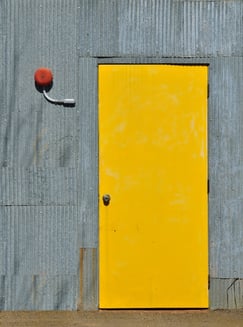
The Building regulations 2010 Part L2 covers the energy efficiency requirements for non-residential buildings. They are divided into Part L2A which covers new build and...
The Building regulations 2010 Part L2 covers the energy efficiency requirements for non-residential buildings. They are divided into Part L2A which covers new build and Part L2B which covers renovations.
We've given an introduction to the Part L2 regulations in an earlier post, which talks about what buildings they do and don't cover and what they look for. If you haven't already read it, we recommend that you do so before reading this post.

Here we go into the nitty-gritty of the criteria a building must meet to be approved by the regulations. Part L2A is broken down into five criteria. Part L2B is broken down slightly differently but cover the same areas, so we'll follow the L2A format here:
Before any work is carried out, the target emission rate (TER) must be calculated based on a model building. The building emission rate (BER) is then calculated from the plans to confirm that the building meets the target.
The type of fuel used to power the fixed building services is important here, as each type of fuel is given a weighting based on how much carbon dioxide it emits per unit of energy it supplies. The efficiency of mains gas gives it a low weighting while the relatively poor efficiency of electricity gives it a high weighting. The lowest weighting is for biogas.
 Control systems are incorporated into the BER calculations as they can improve the overall efficiency. The regulations specify how much the overall BER can be offset for different management features, with the best being the continuous monitoring of energy usage with an automatic notification to whoever is operating the systems if the values go out of the target ranges.
Control systems are incorporated into the BER calculations as they can improve the overall efficiency. The regulations specify how much the overall BER can be offset for different management features, with the best being the continuous monitoring of energy usage with an automatic notification to whoever is operating the systems if the values go out of the target ranges.
In a new building, the Part L2 regulations demand that high-efficiency systems must at least be considered when the building is designed. The type of systems they have in mind include decentralised renewable supply systems such as on-site solar panels or biogas, cogeneration that makes use of waste heat or anything else that is relevant to the type and use of the building.
The figures must be calculated for the initial design of the building, and again once the building or renovations have been completed to make sure that any changes haven't pushed the BER too high.
There is some flexibility in how the TER is met. For example, some inefficiencies in the lighting may be offset by generating electricity on site with solar panels. Criterion 2 limits that flexibility by defining minimum values for the insulation of the building fabric and by mandating that fixed building services like heating, lighting and hot water are controlled to maximise efficiency.
To measure the insulation, each thermal element (walls, floors and ceilings) must have a U-value calculated: the heat flow over 1m2 in one hour when there is a difference of 1K (1°C) between one side of the wall and the other. In practice, it's a good idea to make sure the building's U-values are designed to be substantially better than the standards to allow for some flexibility to make changes during construction. The Part L2  regulations define the maximum U-value allowable for each type of thermal element and are slightly more stringent in renovations than in new buildings.
regulations define the maximum U-value allowable for each type of thermal element and are slightly more stringent in renovations than in new buildings.
If the renovations involve material change of use or consequential improvement, the regulations mandate a review of the existing thermal elements. If their U-values exceed certain thresholds, they must be improved by insulating them to a lower U-value which is given in the regulations. In this case, the U-value is roughly the same as for new build.
A major exemption to the regulations on insulation is a display window, which many shops and cafes would struggle to do without. The regulations state that it's only a display window if it's directly adjacent to where pedestrians are likely to be walking, it's no more than 3m high and it doesn't open on to a workspace. Presumably, they're worried that someone will want to stretch the definition of a display window beyond what they have in mind.
This one is aimed at limiting the need for air-conditioning by making sure that the summer sun doesn't heat the building above certain threshold values. The values are based on a g-value: a measure of how much of the sunlight hitting the surface of the building is translated into heat inside it.
 The regulations only apply to the parts of the building that are intended to be permanently occupied, air-conditioned or both. Offices and classrooms must comply with the regulations whether or not they are air-conditioned while toilets and corridors, which are classed respectively as areas of transient occupancy and circulation spaces, are exempt as long as they're not air-conditioned. Display windows also fall into the exempt categories, so the regulations have nothing to say even if a café's customers feel they are drinking lattes in a greenhouse.
The regulations only apply to the parts of the building that are intended to be permanently occupied, air-conditioned or both. Offices and classrooms must comply with the regulations whether or not they are air-conditioned while toilets and corridors, which are classed respectively as areas of transient occupancy and circulation spaces, are exempt as long as they're not air-conditioned. Display windows also fall into the exempt categories, so the regulations have nothing to say even if a café's customers feel they are drinking lattes in a greenhouse.
The regulation document makes the point that the criterion only considers direct sunlight, so even if a room is so well ventilated that the hottest day only heats it to the level of being pleasantly warm when it's empty, it may need air conditioning to avoid being unbearably hot when it's full of people and equipment.
This part kicks in when construction or renovation is complete. It involves checking that any changes made to the plans have not dramatically affected the BER and that the BER remains below the TER.
Most of the assessment calculated from the plans, along with a site inspection reports to confirm that the building is what the plans say it is. The calculations should confirm that the building services and the thermal envelope should be as efficient as they're supposed to be. There's particular emphasis in possible gaps in the thermal envelope, such as party walls and thermal bridges: weak points in the insulation such as at the joints between walls, floor and ceiling. The regulations recognise that some thermal bridges are unavoidable, but states that there should be none that they call 'reasonably avoidable'.
The only physical test is the pressure test for air permeability, which is necessary for most types of new builds but not renovations. Once all ventilation is sealed and the building is pressurised to 50Pa, the air permeability must be below 10m3 per hour per m2 of floorspace.
There are certain exceptions to the requirement for pressure testing. Any building with a floorspace of less than 500m2 of usable floorspace may avoid being tested, but the air permeability will be given as 15m3 per hour per m2 of floorspace which is a high figure that must be compensated with greater energy efficiency elsewhere in the design, so it may still be worth doing the physical test.
There are also provisions for large extensions built on to existing buildings and for complex or compartmentalised buildings, where the air permeability test may not be practical. In those cases, it may be possible to test a representative part of the building or to use a figure calculated from the building design.

Air permeability is not only a concern for the building as a whole but also for ductwork, which must also be tested to ensure it retains pressure. The requirement to test ductwork applies not only to new builds but also to new or refurbished ductwork in existing buildings.
Criterion 4 also applies when the fixed building services are brought online, so their actual power usage can be calculated for the BER. The regulations recommend a commissioning plan covering the schedule for anything that's more complicated than simply switching it on, as well as any inspections that need to be done.
Once everything has been built, installed, switched on or whatever else it needs, it's necessary to make sure that the building's owner knows how to make the most of its design. In practice, that's likely to mean a document explaining the design features of the building and how to operate it in the most efficient way, which would cover anything from when to open the windows to how to program the water heating system. The data used to calculate the TER and BER should also be given to the owner.
If we haven't covered something you'd like to know, ask us using the contact form below and we'll be happy to help.

The Building regulations 2010 Part L2 covers the energy efficiency requirements for non-residential buildings. They are divided into Part L2A which covers new build and...

The Building Regulations Part L set the energy efficiency standards for residential buildings. They are divided into part L1A, which covers new build, and part L1B,...